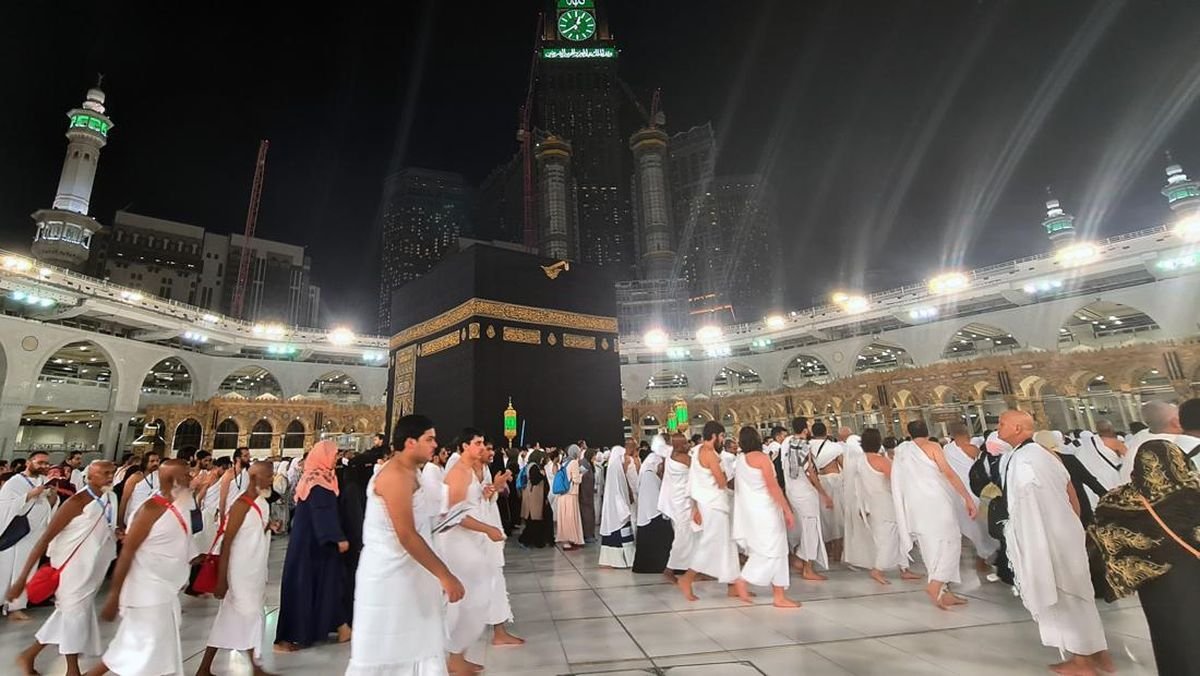Tawaf Ketika Akan Meninggalkan Kota Mekah Dalam Rangkaian Ibadah Haji Disebut Tawaf

Tawaf ketika akan meninggalkan kota Mekah dalam rangkaian ibadah haji disebut tawaf. This sacred act offers pilgrims a moment of reflection and gratitude as they prepare to conclude their spiritual journey. Walking in circles around the Kaaba, believers express their devotion and seek blessings before returning home.
Each lap of tawaf symbolizes a connection to the divine, reminding devotees of their faith and the significance of their pilgrimage. As the final gesture in this holy city, it encapsulates the essence of Hajj and leaves an indelible mark on the hearts of those who partake in it.
Understanding Tawaf Ketika Akan Meninggalkan Kota Mekah dalam Rangkaian Ibadah Haji Disebut Tawaf
Tawaf is one of the significant rituals in the Hajj pilgrimage, especially when performed as farewell Tawaf, often referred to as “Tawaf Wida.” In this section, we will delve deep into the meaning, significance, and procedures of this important act that marks the completion of one’s pilgrimage in the holy city of Mekah.
What is Tawaf?
Tawaf is the act of circling the Kaaba, the sacred structure at the center of the Masjid al-Haram in Mekah. Pilgrims perform tawaf as a part of their Hajj rituals, expressing devotion and submission to Allah. It consists of the following key elements:
- **Seven Circuits:** Pilgrims circle the Kaaba seven times, starting from the Black Stone (Hajar al-Aswad).
- **Counterclockwise Direction:** Each circuit is made in a counterclockwise direction, symbolizing the unity of believers in the worship of the One God.
- **Supplication and Reflection:** Many pilgrims engage in personal prayers and reflections during tawaf, seeking forgiveness and blessings.
Significance of Tawaf Wida
Tawaf Wida, or farewell Tawaf, is a heartfelt act performed by pilgrims as they prepare to leave Mekah. Here are a few reasons why this ritual holds immense significance:
- **Final Connection:** It serves as a way for pilgrims to reaffirm their connection with the sacred site before departing.
- **Seeking Blessings:** Many believe that performing Tawaf Wida helps in seeking blessings for their journey home.
- **Symbol of Departure:** It symbolizes the end of the pilgrimage journey, wrapping up the spiritual experience in a profound manner.
When to Perform Tawaf Wida
Tawaf Wida should ideally be performed right before leaving Mekah. Understanding the right timing can enhance its spiritual significance. Here’s a closer look:
Recommended Timing
– **On the Last Day of Hajj:** The best time to perform tawaf is on the final day of the Hajj pilgrimage.
– **Before Leaving for Home:** If a pilgrim intends to leave Mekah, they should prioritize Tawaf Wida before their departure.
– **Avoiding Rush Hours:** Pilgrims should consider the crowd and try to avoid busy hours for a more spiritually uplifting experience.
Special Cases
– If a pilgrim has to stay longer in Mekah, Tawaf Wida can still be performed before leaving for other destinations.
– It is crucial to note that Tawaf Wida is not obligatory but is highly recommended.
How to Perform Tawaf Wida
Performing Tawaf Wida involves a few steps that ensure pilgrims conduct it correctly. Let’s break it down:
Preparation for Tawaf
Before starting Tawaf Wida, pilgrims should prepare themselves both spiritually and physically:
– **Purity:** It is highly recommended to be in a state of wudu (ablution).
– **Intention:** Make a sincere intention in your heart to perform Tawaf Wida for the sake of Allah.
– **Dress Appropriately:** For men, the white ihram attire symbolizes purity, while women should wear modest clothing as per Islamic guidelines.
Steps to Perform Tawaf
1. **Approach the Kaaba:** Walk calmly towards the Kaaba, focusing on your intention and prayers.
2. **Start at the Black Stone:** If possible, touch the Black Stone with your right hand and say, “Bismillah, Allahu Akbar.” If you cannot reach it due to crowds, simply point towards it.
3. **Make Your Circuits:** Walk counterclockwise around the Kaaba, completing seven circuits.
4. **Engage in Dhikr and Dua:** During the tawaf, recite prayers, supplications, and reflect on your experiences during Hajj.
5. **Conclude at the Black Stone:** Finish your tawaf at the Black Stone, saying “Allahu Akbar” once again, if you can reach it.
Final Dua
After completing Tawaf Wida, many pilgrims offer a final heartfelt dua, seeking forgiveness and the acceptance of their Hajj. This is a moment for deep reflection and gratitude.
Common Mistakes to Avoid
To ensure a smooth and spiritually rewarding experience, it’s essential to be aware of common pitfalls pilgrims might face during Tawaf Wida:
- **Rushing:** Take your time; tawaf is about reflection and connection, not speed.
- **Neglecting Dua:** Some pilgrims may forget to engage in personal supplications; make this a priority.
- **Ignoring Physical Condition:** Be mindful of your physical abilities and avoid overexertion, especially in crowded environments.
The Spiritual Benefits of Tawaf Wida
The farewell tawaf offers many spiritual benefits that can impact a pilgrim’s life beyond the Hajj journey:
Reinforcement of Spiritual Teachings
– **End of a Journey:** It signifies the closing of a spiritual chapter, allowing worshippers to carry lessons learned during Hajj into their everyday lives.
– **Connection with Allah:** By engaging in this last act of worship, pilgrims reinforce their bond with the Almighty, encouraging ongoing spirituality and devotion.
Increased Sense of Community
– **Shared Experience:** Tawaf Wida is often performed with fellow pilgrims, reinforcing the sense of community and shared purpose in the faith.
– **Global Fellowships:** Witnessing individuals from diverse backgrounds come together enhances understanding and unity within the Islamic community.
Post-Tawaf Considerations
After completing Tawaf Wida, pilgrims should have a plan for their departure and how to maintain their spiritual state:
Making the Most of Your Return Journey
– **Reflect:** Use your journey home as a time for reflection, thinking about your experiences in Mekah and how they can shape your future actions.
– **Stay Connected:** Engage with your local mosque or Islamic community to continue your spiritual growth.
– **Share Your Journey:** Consider sharing your Hajj experiences with friends and family. This not only spreads awareness but also fortifies your own memories.
Maintaining Spirituality After Hajj
– **Regular Prayer:** Make a routine of performing prayers and engaging in dhikr daily.
– **Acts of Charity:** Continue the spirit of giving by participating in charitable acts.
– **Education:** Seek knowledge about your faith through reading and attending lectures.
The farewell tawaf, or Tawaf Wida, is a beautiful conclusion to the Hajj pilgrimage, representing the culmination of a profound spiritual journey. Embracing this moment with intention and mindfulness can lead to lasting impacts on one’s spiritual life. Pilgrims should cherish this opportunity as they leave the sacred city of Mekah, taking with them all the blessings and lessons from their pilgrimage.
Tawaf Wada' atau Tawaf Pamitan || Untuk Jamaah Umrah dan Haji
Frequently Asked Questions
“`html
What is the significance of Tawaf Wada in the Hajj pilgrimage?
Tawaf Wada, or the farewell circumambulation, holds great significance in the Hajj pilgrimage as it symbolizes the pilgrim’s respect and love for the Sacred House of Allah. It acts as a final act of devotion before leaving Mecca, reminding the pilgrims of the spiritual journey they have undertaken. It expresses gratitude for the opportunity to perform Hajj and serves as a way to seek blessings for the return journey home.
How many circuits must one complete during Tawaf Wada?
During Tawaf Wada, pilgrims must complete seven circuits around the Kaaba. Each circuit is a demonstration of devotion and obedience to Allah. After completing the Tawaf, pilgrims often make supplications and prayers, emphasizing the importance of this farewell act in their spiritual journey.
Can individuals who are not performing Hajj participate in Tawaf Wada?
No, Tawaf Wada is specifically a rite designated for those who are performing Hajj. It is a farewell act exclusive to pilgrims completing their Hajj obligations. However, other types of tawaf, such as Tawaf Qudum (arrival) or Tawaf Sunnah, are open to all visitors of the Kaaba, regardless of their Hajj status.
What is the recommended time to perform Tawaf Wada?
It is recommended to perform Tawaf Wada before leaving Mecca, ideally on the last day of the pilgrimage, just before departing for home. Pilgrims should plan their time accordingly to ensure they can complete this important ritual without feeling rushed.
Are there specific supplications recommended during Tawaf Wada?
While performing Tawaf Wada, pilgrims can recite any prayers and supplications that come from their heart. However, it is recommended to include the supplications that Prophet Muhammad (peace be upon him) taught, such as seeking forgiveness, mercy, and guidance. Many choose to pray for loved ones and for a safe journey home.
“`
Final Thoughts
Tawaf ketika akan meninggalkan kota Mekah dalam rangkaian ibadah haji disebut tawaf. This ritual signifies the culmination of a pilgrim’s journey, allowing them to bid farewell to the holy city. Performing tawaf is a moment of reflection and gratitude for the spiritual experiences gained during Hajj. As pilgrims complete this final act of devotion, they carry the blessings of their journey back home.







